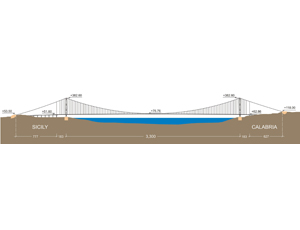
More than 2,000 years of planning for a fixed link between Italy and the island of Sicily came tantalizingly close to fruition in 2006 when a construction contract was signed. But with designs approved and preparatory site work in hand, the state company behind the $5-billion project shut its doors last year and work was indefinitely shelved.
Transportation and infrastructure minister Maurizio Lupi is on record as still supporting the project but, as Italy grapples with mountainous public debt, other priorities exist, he says.
Earlier this year, Lupi authorized studies into the Strait of Messina’s transportation needs, with the bridge no longer in the picture.
With a 3,330-m main span the bridge would have beaten the current record holder, Japan's Akashi Kaikyo crossing, by 39%. Its cables would have been so large, at over 1.2 m dia, that they would have used around 40% of their strength to support themselves.
To prevent the super long crossing from twisting in the wind, it was to be divided into three interlinked decks with the intervening gaps equalizing air pressure between the top and bottom surfaces.
Like many projects of such scale, the Messina Strait bridge has had a long history. In modern times, plans started taking shape with an international competition for ideas in the late 1960s leading to the selection of a single span bridge more than two decades later.
Ten years ago, the state-owned project company Stretto di Messina S.p.A. (SdM) launched an international competition for the bridge’s turnkey construction and partial debt funding. Established in 1981, SdM had a 30-year concession to procure and operate the crossing. The company was liquidated last year.
A joint venture called Eurolink, led by Italy’s then largest contractor Impregilo S.p.A. won the bid in 2005, signing the contract the following year.
The joint venture also included Japan's Ishigawajima-Harima Heavy Industries, Co. Ltd., Tokyo, among others, with Denmark’s Cowi A/S acting as lead designer.
After Prime Minister Silvio Berlusconi lost power in 2006, the project was suspended by the successor government. But Berlusconi’s return in 2008 revived the contract and preparatory work finally got under way in 2009 with a 2017 completion deadline for the crossing.
With the deepening economic crisis and Berlusconi’s political defeat in 2011, once again the world's longest bridge reverted to dream status.



Post a comment to this article
Report Abusive Comment